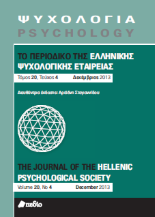Κίνητρα φιλοκοινωνικής συμπεριφοράς: Αγνός αλτρουισμός ή ψυχολογικός εξαναγκασμός;

Περίληψη
Η παρούσα έρευνα έχοντας ως θεωρητική αφετηρία τη διαμάχη ανάμεσα στην Yπόθεση Ενσυναίσθησης-Αλτρουισμού και την Υπόθεση της Αποφευκτικής Μείωσης της Εξαψης για την ερμηνεία της φιλοκοινωνικής συμπεριφοράς μελετά τα κίνητρα που υπογραμμίζουν την εκδήλωση συμπεριφοράς βοήθειας. Για τον λόγο αυτό σχεδιάστηκε πειραματική διαδικασία στην οποία έλαβαν μέρος ενήλικοι άνδρες και γυναίκες (Ν = 128). Αρχικά οι συμμετέχοντες συμπλήρωσαν την κλίμακα των τάσεων φιλοκοινωνικής συμπεριφοράς (Prosocial Tendencies Measure - Carlo & Randall, 2002) και το Ερωτηματολόγιο του Τορόντο για την ενσυναίσθηση (The Toronto Empathy Questionnaire - Spreng και συν., 2009). Στη συνέχεια διαχωρίστηκαν σύμφωνα με τις απαντήσεις τους σε 8 ομάδες και εκτέθηκαν σε αντίστοιχες πειραματικές συνθήκες (2 γνωστός-άγνωστος Χ 2 σε ανάγκη βοήθειας-απουσία ανάγκης βοήθειας Χ 2 άσκηση πίεσης για λήψη βοήθειας-απουσία άσκησης πίεσης για λή-
ψη βοήθειας). Τα ευρήματα δείχνουν ότι το επίπεδο ενσυναίσθησης παίζει ρόλο στην εκδήλωση συμπεριφοράς βοήθειας. Περισσότερο, όμως, βρέθηκε να επηρεάζει την εκδήλωση φιλοκοινωνικής συμπεριφοράς
η μεταβλητή της οικειότητας με το άτομο, καθώς και το εάν το άτομο που βρίσκεται σε ανάγκη ζητά βοήθεια. Τα ευρήματα υποδεικνύουν ότι η εκδήλωση συμπεριφοράς βοήθειας συνιστά αποτέλεσμα άσκησης
ψυχολογικής πίεσης και μοιάζει να υπακούει στο κίνητρο της ψυχολογικής απόδρασης από συνθήκες έκθεσης σε αίτημα για εκδήλωση συμπεριφοράς βοήθειας.
Λεπτομέρειες άρθρου
- Πώς να δημιουργήσετε Αναφορές
-
Λαμπρίδης Ε. (2020). Κίνητρα φιλοκοινωνικής συμπεριφοράς: Αγνός αλτρουισμός ή ψυχολογικός εξαναγκασμός;. Ψυχολογία: το περιοδικό της Ελληνικής Ψυχολογικής Εταιρείας, 21(3), 354–370. https://doi.org/10.12681/psy_hps.23503
- Τεύχος
- Τόμ. 21 Αρ. 3 (2014)
- Ενότητα
- ΕΙΔΙΚΟ ΑΦΙΕΡΩΜΑ

Αυτή η εργασία είναι αδειοδοτημένη υπό το Creative Commons Attribution-ShareAlike 4.0 International License.
Το περιοδικό ΨΥΧΟΛΟΓΙΑ έχει υιοθετήσει μία πολιτική Platinum open-access. Τα έξοδα υποβολής, επεξεργασίας ή δημοσίευσης των εργασιών καλύπτονται από την Ελληνική Ψυχολογική Εταιρεία. Τα πνευματικά δικαιώματα των δημοσιευμένων εργασιών προστατεύονται από την άδεια 'Creative Commons Attribution-ShareAlike 4.0 International'. Οι Συγγραφείς διατηρούν τα Πνευματικά Δικαιώματα και χορηγούν στο περιοδικό το δικαίωμα της πρώτης δημοσίευσης. Η άδεια αυτή επιτρέπει σε τρίτους, να χρησιμοποιούν την εργασία σε οποιαδήποτε μορφή, με την προϋπόθεση της διατήρησης των διατυπώσεων που προβλέπονται στην άδεια σχετικά με την αναφορά στον αρχικό δημιουργό και την αρχική δημοσίευση στο περιοδικό ΨΥΧΟΛΟΓΙΑ. Επιπλέον, κάθε διανομή της εργασίας οφείλει να γίνεται με τους ίδιους όρους διανομής, δηλαδή με την ίδια άδεια Creative Commons.





